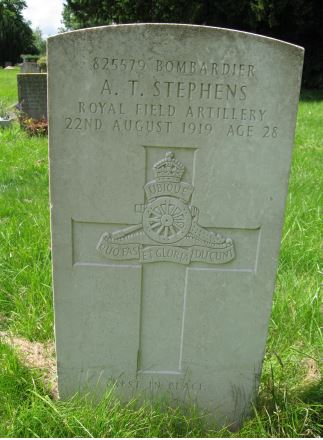1st South Midland Brigade, Royal Field Artillery

‘Bert’ Stephens (as he appears to have been known) appears to have served throughout the Great War, only to succumb to illness shortly after it.
Albert Thomas Stephens was born in Hardwicke in 1891, the son of William Stephens (1861-1920), an agricultural labourer his wife Mary Jane (née Barrow: 1866-1937). According to the 1911 Census the couple had eight children, seven of whom were living in that year. In 1901 the family lived at Park End Bridge, Hardwicke and by 1911 had moved to Waterwells Cottage, Quedgeley. At some point between 1911 and the start of the Great War a further move was made, to Brook Cottage, Green Lane, Hardwicke.
An Army Service Record has survived for Bert and this shows that he enlisted in Gloucester on 3 September 1914 and joined the 1st South Midland Brigade, Royal Field Artillery. He was allocated the number 1777. He gave his occupation as a carter (or driver) and his age (correctly) as 23.
Initially he signed on for one year’s service as a home based Territorial but obviously the length of service and commitment changed, as the war progressed. The service record tells us that he served in the UK from 3 September 1914 to 28 March 1915 and was with the British Expeditionary Force (BEF) in France and Flanders from 29 March until October 1917 (exact date is indistinct in the record) and thereafter in Italy until 26 January 1919. He spent the period 27 January 1919 to 6 March of that year back in the UK, before being discharged into the Reserve.
We know from the service record that from 6 April 1918 he was a Driver, with ‘C’ Battery, 240th Brigade. He must at some point have been promoted to Bombardier (equivalent of Corporal) and in early 1917 he was given a new number (825579), when all Territorial Force personnel were allocated new six digit numbers.
The 240th Brigade was formerly 1st South Midland Brigade and the Imperial War Museum has, as part of its collections, a volume entitled History of the 240th Brigade (1st South Midland Brigade), Royal Field Artillery 1914-1918. It includes details about mobilisation and drill in Plymouth and Broomfield and the departure for France aboard the SS Huanchaco on 30 March 1915. The brigade experienced the first gas attack in the Ypres Salient in April, 1915 and the build up to the Somme Offensive in June 1916. Thereafter it was involved in the Third Battle of Ypres (July to October 1917) in increasingly poor conditions, before transferring to the Italian Front in October 1917, where it saw action at the Battle of the Piave River in June 1918 and Vittoria Veneto (October 1918), before the declaration of the Armistice with Austria-Hungary the following month.
Bert was de-mobilised on 6 March 1919 and remained as a Reservist. It is not known if he was able to resume civilian employment until he died, aged 28, at home in Green Lane, Hardwicke, on 22 August 1919. A recently released Pension Record Card (PRC) says that he was suffering from heart disease.
The Gloucester Journal of 30 August 1919 carried a report of his funeral. It stated that he died ‘after a long illness due to the effects of the Great War’. The PRC bears a note indicating that this was not seen as attributable to war service.
Bert’s funeral, with military honours, was held at Hardwicke (St Nicholas) Church, when the lesson was read by his former CO, Lieutenant Colonel Arthur Lloyd-Baker. Fellow members of the ‘Hardwicke Post’ of the ‘Comrades of the Great War’ were in attendance, alongside family members and friends. He was buried in the churchyard, where standard CWGC headstone now marks his grave.
Researched by Graham Adams 14 December 2020
